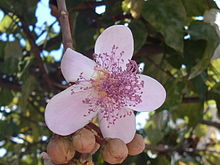Bixa orellana
| Achiote | |
|---|---|

| |
| An achiote blossom | |
| Scientific classification | |
| Kingdom: | |
| (unranked): | |
| (unranked): | |
| (unranked): | |
| Order: | |
| Family: | |
| Genus: | |
| Species: | B. orellana
|
| Binomial name | |
| Bixa orellana | |
Achiote (Bixa orellana) is a shrub or small tree from the tropical region of the Americas. The name derives from the Nahuatl word for the shrub, achiotl. It is also known as Aploppas, and its original Tupi name urucu. It is cultivated there and in Southeast Asia, where it was introduced by the Spanish in the 17th century. It is best known as the source of the natural pigment annatto, produced from the fruit. The plant bears pink flowers and bright red spiny fruits which contain red seeds. The fruits dry and harden to brown capsules.
Characteristics
The inedible fruit is harvested for its seeds, which contain annatto, also called bixin. It can be extracted by stirring the seeds in water. It is used to color food products, such as cheeses, fish, and salad oil. Sold as a paste or powder for culinary use, mainly as a color, it is known as "achiote," "annatto," "bijol," or "pimentão doce." It is a main ingredient in the Yucatecan spice mixture recado rojo, or "achiote paste." The seeds are ground and used as a subtly flavored and colorful additive in Latin American, Jamaican, Chamorro and Filipino cuisine. Annatto is growing in popularity as a natural alternative to synthetic food coloring compounds. While it has a distinct flavor of its own, it can be used to color and flavor rice instead of the much more expensive saffron. It is an important ingredient of cochinita pibil, the spicy pork dish popular in Mexico. It is also a key ingredient in the drink tascalate from Chiapas, Mexico.
In several European countries (e.g. Great Britain, Denmark, Sweden, Norway) the pigment, extracted by solvent or boiling the seeds in oil, have been and often still is used as color in margarines and several other foods. The pigment has E-number E160b. The seeds are collected from wild-growing bushes or from plantations, in Latin America, Africa (e.g. Kenya) and Asia. However, since there is no strong organization promoting the use of annatto, the synthetic color beta carotene, which is more expensive, has pushed the natural pigment out of many applications. [citation needed]
Ethnomedical uses
- The achiote has long been used by American Indians to make body paint, especially for the lips, which is the origin of the plant's nickname, lipstick tree. The use of the dye in the hair by men of the Tsáchila of Ecuador is the origin of their usual Spanish name, the Colorados.
References
- B. orellana and annatto
- Van Wyk, Ben-Erik (2005). Food Plants of the World. Portland, Oregon: Timber Press, Inc. ISBN 0-88192-743-0
Gallery
-
with fruits in Hyderabad, India.
-
with fruits in Hyderabad, India.
-
fruit in Hyderabad, India.
-
dried fruit in Hyderabad, India.
-
fruiting branch showing seed pod
-
cluster of seed pods
-
Split seed pod
-
Half of a seed pod showing seeds inside
-
Edison & Ford Winter Estates, Ft Myers, Florida. (2 of 3)
-
Edison & Ford Winter Estates, Ft Myers, Florida. (3 of 3)
- Malvales
- Medicinal plants
- Plant dyes
- Native crops of Mexico
- Flora of Belize
- Flora of Costa Rica
- Flora of El Salvador
- Flora of Guatemala
- Flora of Honduras
- Flora of Nicaragua
- Flora of Panama
- Flora of French Guiana
- Flora of Guyana
- Flora of Suriname
- Flora of Venezuela
- Native crops of Brazil
- Native crops of Bolivia
- Native crops of Colombia
- Native crops of Ecuador
- Native crops of Peru
- Trees of Mexico
- Trees of Brazil
- Fruit tree stubs










